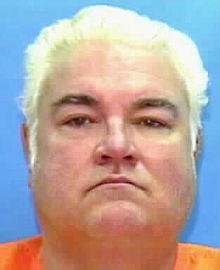Allen Lee Davis | |
|---|---|
 Mug shot of Davis | |
| Born | July 20, 1944 Jacksonville, Florida, U.S. |
| Died | July 8, 1999 (aged 54) |
| Other names | Tiny, Bud |
| Occupation | Welder |
| Height | 5 ft 10 in (178 cm) |
| Criminal status | Executed |
| Criminal charge | Three counts of first-degree murder |
| Penalty | Death by electric chair |
| Details | |
| Victims | 3 |
| Country | United States |
| State(s) | Florida |
Date apprehended | 1982 |
Allen Lee Davis (July 20, 1944 – July 8, 1999) was an American mass murderer who was executed for the May 11, 1982, murder of Nancy Weiler, who was three months pregnant, in Jacksonville, Florida. According to reports, Nancy Weiler was "beaten almost beyond recognition" by Davis with a .357 Magnum, and hit more than 25 times in the face and head. He was also convicted of killing Nancy Weiler's two daughters, Kristina, age 10, who was shot twice in the face, and Katherine, age 5, who was shot as she tried to run away and then had her skull beaten in with the gun. Davis was on parole for armed robbery at the time of the murders.
Davis was executed on July 8, 1999, via electrocution.[1] His execution was considered botched, with witnesses reporting that Davis was still alive after the power to Old Sparky was switched off. Blood had also leaked from Davis's nose during the execution, although prison officials claim this was caused by a nose bleed. Because of the controversy surrounding his execution, Davis remains the last person executed by electric chair in Florida.[2] All subsequent executions in Florida have been carried out by lethal injection, although inmates can still choose to be executed by electric chair.
Execution
Last meal
For his last meal, Davis requested and received a dinner consisting of one lobster tail, fried potatoes, a half pound of fried shrimp, six ounces of fried clams, half a loaf of garlic bread, and 32 ounces of Barq's Root Beer.[3]
Controversy
Davis's execution drew nationwide media attention after he bled profusely from the nose while being electrocuted. Also during his time in the electric chair, Davis suffered burns to his head, leg, and groin area. A subsequent investigation concluded that Davis had begun bleeding before the first jolt of electricity was applied.[4] He had been taking blood thinning medication for an unrelated health problem. It was concluded that the electric chair had functioned as designed and the Florida Supreme Court upheld electrocution as a means of capital punishment. However, a dissenting justice published photos of the aftermath of the incident in an attempt to argue that the practice of capital punishment by electrocution was outdated, and that any future executions should be carried out through lethal injection.[5] In 1999, the state of Florida heard a petition from Thomas Harrison Provenzano, another death row inmate, that argued that the electric chair was a "cruel and unusual punishment". As of 2021, Davis was the last Florida inmate executed by electric chair. Since 2000, all subsequent executions were by lethal injection. Inmates, however, may still choose electrocution. As of 2021, only Wayne C. Doty has opted for death by electrocution.[6]
See also
- Capital punishment in Florida
- Capital punishment in the United States
- List of people executed in Florida
- List of botched executions
References
- ^ "Allen Lee "Tiny" Davis Executed July 8, 1999 by Electric Chair in Florida". ClarkProsecutor.org. Retrieved November 12, 2009.
- ^ "From bloodied shirts and shuddering to HEADS on fire: Death Row witness reveals inmates' most chilling final moments". Daily Mirror. March 9, 2018.
- ^ "Allen Lee "Tiny" Davis - Last meals of death row inmates". CBS News. Retrieved January 7, 2021.
- ^ "Florida's Messy Executions Put the Electric Chair on Trial". The New York Times. November 18, 1999.
- ^ "Lawyers use gruesome pictures in battle to ban Old Sparky". The Guardian. September 4, 1999.
- ^ "Death row inmate requests electric chair, Florida law may make it possible". WFTS-TV. July 15, 2017.
External links
- DC.State.fl.us, Inmate Release Information Detail - Inmate 040174. Florida Department of Corrections. Retrieved on 2008-05-29.
- DC.State.fl.us, August 3, 1999 Order Upholding Constitutionality of the Electric Chair. Florida Department of Corrections (1999-08-03). Retrieved on 2008-05-29.